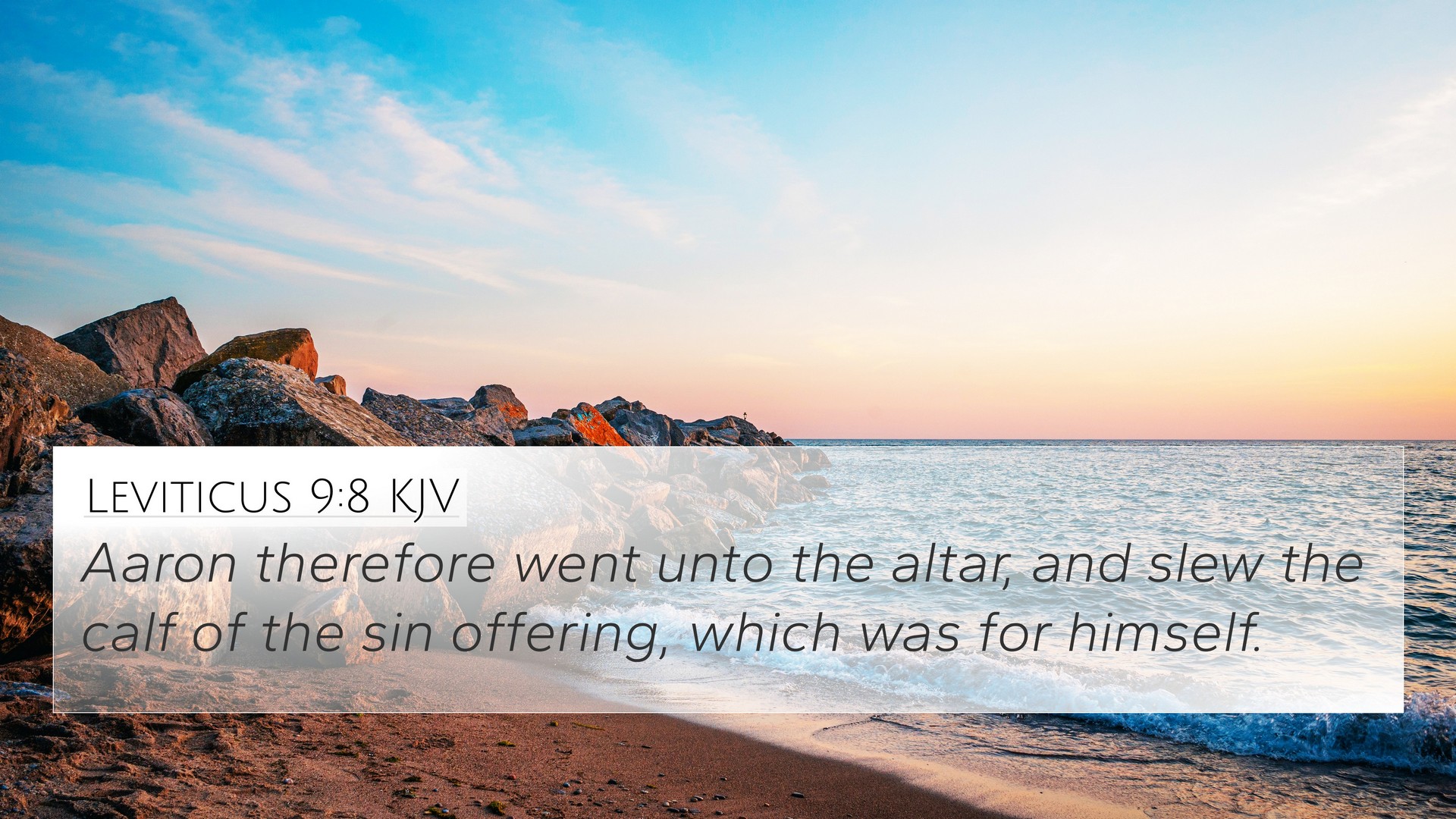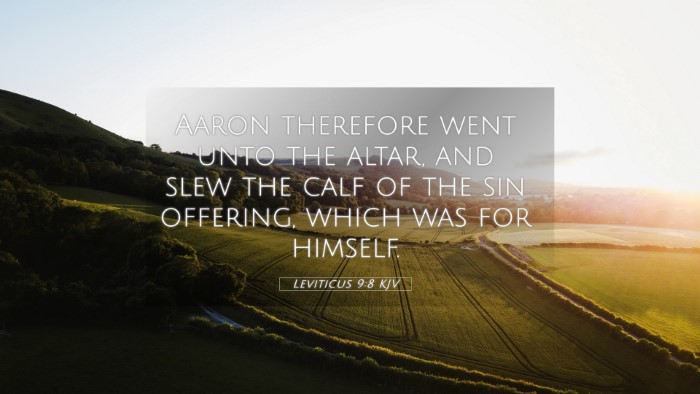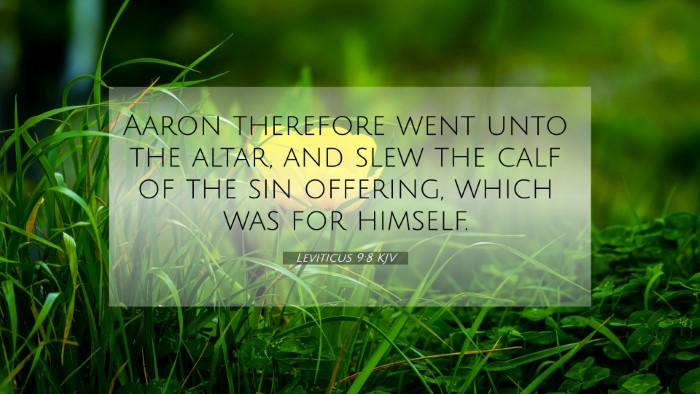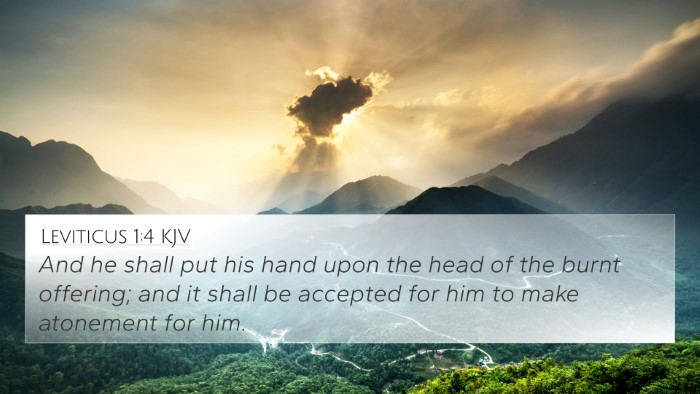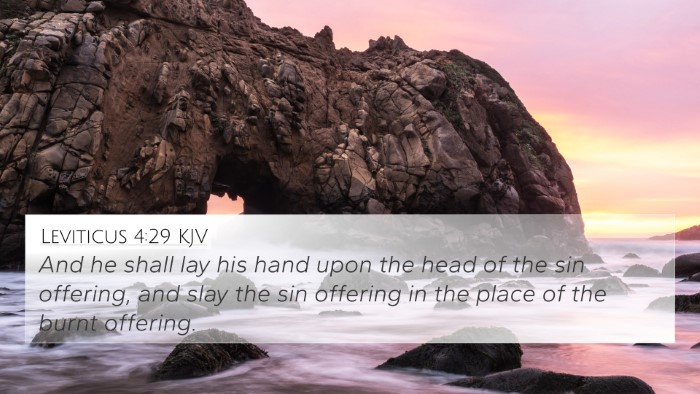Understanding Leviticus 9:8
Leviticus 9:8 states: "Aaron therefore went unto the altar, and slew the calf of the sin offering, which was for himself." This verse marks the initiation of the sacrificial system, highlighting the critical role of the priest in making atonement for sins. The act performed by Aaron symbolizes not only a ritualistic practice but also reflects deeper theological meanings regarding sin, atonement, and the intercession of a mediator.
Significance of Aaron's Action
Aaron’s approach to the altar reveals several key themes covered in various public domain commentaries. Matthew Henry emphasizes that Aaron acts in obedience to God’s command, marking the sanctification of the priestly office, which is central to the worship practices of Israel. Albert Barnes highlights the necessity of the sin offering, portraying it as a necessary step for Aaron before he could enter the holy presence of God and represent the people. Adam Clarke notes the priest's need for personal atonement before interceding for others, thus establishing the principle of representation in the sacrificial system.
The Priestly Role
The verse encapsulates the responsibility entrusted to the priest. The act of slaying the calf signifies the bearing of sin through sacrifice, which would be a recurrent theme in the Levitical laws. As noted in Leviticus 4:3-12, the importance of the priest’s own purification is elucidated, ensuring that he is spiritually fit to make atonement for the people.
Cross-References to Leviticus 9:8
- Leviticus 4:3 (The sin offering for the high priest)
- Exodus 28:41 (Consecration of Aaron and his sons)
- Hebrews 5:3 (Priests have to make atonement for themselves)
- Hebrews 7:27 (Christ as the perfect high priest)
- Romans 8:3 (God sending His son as a sin offering)
- Numbers 8:22 (The offerings of the Levites)
- 2 Corinthians 5:21 (Christ made sin for us)
- 1 Peter 2:5 (Believers as a royal priesthood)
- 1 John 1:9 (Confessing our sins for forgiveness)
- Isaiah 53:5 (The suffering servant bearing our iniquities)
Thematic Connections in Scripture
The sacrificial system articulated in Leviticus 9:8 resonates throughout the entirety of Scripture. It sets a precedent for understanding redemption in both the Old and New Testaments. The need for a mediator is visually depicted through Aaron’s actions, which prefigures the ultimate mediation presented through Christ.
Connections between Old and New Testament
As noted by various commentaries, including Matthew Henry's insights on typology, Aaron’s actions foreshadow Christ's ultimate sacrifice. Where Aaron offered a bull for his own sins, Christ, portrayed in Hebrews 10:12, offered Himself as the one-time perfect sacrifice. This establishes a profound connection, illustrating how the themes of atonement, sin-bearing, and intercession are woven into a greater narrative of divine salvation.
Bible Verse Cross-References
Exploring Tools for Bible Cross-Referencing
For a more enriched Bible study experience, utilizing tools such as a Bible concordance and Bible cross-reference guide can offer insights into the interconnectedness of verses. Understanding these links creates a comprehensive background for theological reflection and personal edification.
How to utilize Bible cross-references:
- Identify key themes in a verse.
- Look for cross-referenced verses that illustrate or contrast these themes.
- Engage in a comparative Bible verse analysis to deepen understanding.
- Utilize a Bible chain reference system to connect verses across different books.
Conclusion
Leviticus 9:8 serves as a pivotal verse in understanding the framework of the sacrificial system that God instituted. By recognizing the weight of sin that Aaron’s act symbolizes, one can appreciate the profound significance of Jesus Christ as the true and final sacrifice for humanity. The intricate web of connections elucidated through cross-referencing biblical texts enriches our understanding of Scripture, urging believers to explore the dynamics of their faith through inter-Biblical dialogues.
